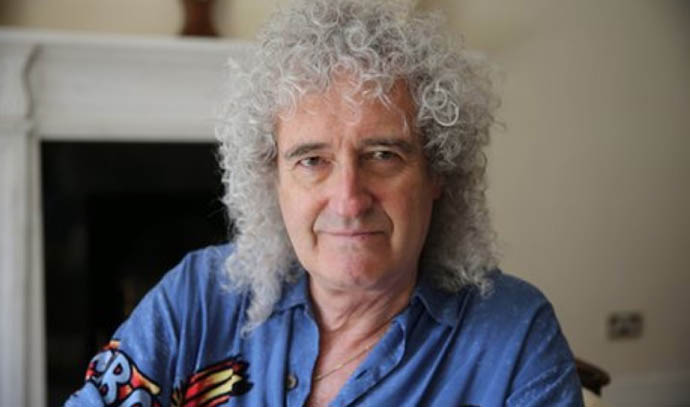Brian has put out the following op-ed along with with Clark Chapman and Thomas Jones
GUARDIAN
30 Jun 2016 by Brian May, Clark Chapman, Thomas Jones
The second annual Asteroid Day takes place today. Credit: Asteroid Day
It’s Asteroid Day, an annual event reminding governments and the public that asteroids are the only major natural disasters we have a chance of preventing
Scientists Rock – an Asteroid Day series | Episode 1
– https://youtu.be/G0NhCzeebjI
We all know the story of the end of the dinosaurs and we joke “If only they had a space programme.” Although Nasa has discovered most of the near-Earth asteroids that could render us extinct, there are a million more we haven’t yet seen that have the potential to devastate any one of our major metropolitan cities around the world.
On 30 June 1908, the date of the last major impact on Earth, a relatively small asteroid approximately 40 metres in size devastated about 2,000 square kilometres of forest in Siberia. The impact energy was at least a 100 times greater than the two nuclear bombs used in WWII. In 2013, just three years ago, another “baby” asteroid, this time only about 20 metres, exploded in the air near the city of Chelyabinsk, Russia, blowing out about 100,000 windows and injuring more than 1,500 people.
Every single day, 365 days a year, the Earth is hit by about 100 tons of fragments of asteroids and comets such as meteoroids and cosmic dust, as it has been for a few billion years – and occasionally these impacts are much larger.
This is why we brought together an esteemed group of planetary scientists, astrophysicists, astronauts, artists, academics and concerned citizens to create Asteroid Day, a day of education and awareness about near-Earth Objects (NEOs) in our Solar System. Asteroid Day is held each year on June 30, the anniversary of the Tunguska impact.

Brian May: Asteroid Day can help protect the planet: READ MORE
In 2015, we were joined by tens of thousands of private citizens at more than 150 self-organised events worldwide and millions of people participated online to learn and think about how we could outsmart the dynamics of the solar system.
Professor Stephen Hawking recently re-emphasised our need to be vigilant: “One of the major threats to intelligent life in our universe is a high probability of an asteroid colliding with inhabited planets.”
While existing telescopes do a good job of monitoring our solar system for the larger asteroids, one kilometre or greater – so we don’t go the way of the dinosaurs – it is much harder to detect the smaller ones, like those that impacted Chelyabinsk and Tunguska, which are still large enough to cause significant destruction. In fact, the aggregate findings of all telescopes combined to date have found less than one percent of NEOs that could cause significant damage.
Asteroids are leftover material from the origins of our solar system. NEOs orbit in the inner solar system, close to Earth, but are small and often dark, so that they are difficult to see. We need to complement our current and future land based telescopes with a space based asset to look for asteroids in the infrared part of the spectrum. According to Eric Christensen, one of our Asteroid Day science advisors, the study of these objects “allows us to look both backward and forward in time and can inform our understanding of the birth and evolution of the solar system.”
Asteroid impacts are the only major natural disasters we have a chance of preventing, unlike earthquakes, tornadoes or hurricanes. To meet our responsibilities in the face of such an avoidable hazard, we need the will to allocate the very modest resources necessary to find them years or decades in advance. Warning time is critical: if we can determine the asteroid’s orbit relative to Earth’s, and see an impact coming, we can deflect the asteroid just by altering its orbital speed. As Asteroid Day science advisor Don Yeomans says, the three most important things for asteroid defence are to “find them early, find them early and find them early.” There are many proposed technologies to do this job, some of which we have in hand, along with other promising techniques which we can test.
Asteroid Day has produced a seven-part film series detailing the global concern over NEOs, with an introduction by our good friend Neil deGrasse Tyson, director of New York’s Hayden Planetarium. The series celebrates asteroid experts, astronauts, scientists, business leaders and policymakers working in this emerging field.
Join in today at one of the hundreds of Asteroid Day events being held around the world and online.
Dr Brian May is a musician, singer, songwriter and astrophysicist, best known as the lead guitarist of the rock band Queen. He is a co-founder of Asteroid Day
Dr Clark Chapman is a renowned planetary scientist and co-founder and on the Board of Directors of B612. He is a winner of the Carl Sagan Award for Public Understanding of Science and worked on the science teams of the MESSENGER, Galileo and Near-Earth Asteroid Rendezvous space missions.
Dr Tom Jones is a member of the Nasa Advisory Council and a former US astronaut and planetary scientist who has studied asteroids for Nasa, engineered intelligence-gathering systems for the CIA, and helped develop advanced mission concepts to explore the solar system. He flew on four space shuttle missions, logging a total of 53 days in space, and his flight time included three spacewalks. His publications include Planetology: Unlocking the Secrets of the Solar System.